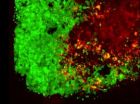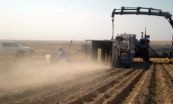(Press-News.org) Targeting microbial translocation attenuates SIV-mediated inflammation
Patients with HIV often present with signs of immune activation and systemic inflammation, both of which are hypothesized to directly contribute to the development of AIDs in infected individuals. HIV and the related simian immunodeficiency virus (SIV) damage the gut mucosa, leading to translocation of microbes from the intestinal lumen to the general circulation, but it is not clear if microbial translocation is directly responsible for chronic HIV-associated inflammation. In this issue of the Journal of Clinical Investigation, Ivona Pandrea and colleagues at University of Pittsburgh report on a study that validates the microbial translocation hypothesis in SIV-infected pigtail macaques. Sevelamer, a drug that is used to reduce systemic LPS levels in chronic kidney disease patients, was given to SIV-infected animlas to reduce microbial translocation in the gut. Compared to controls, sevelamer-treated animals had decreased systemic LPS and reduced activation of peripheral CD4+ T cells. Importantly, sevelamer treatment dramatically lowered viral titers in the blood and reduced coagulation biomarkers that are associated with the development of cardiovascular co-morbidities. In the accompanying commentary, Liang Shan and Robert Siliciano of John's Hopkins School of Medicine discusse how control of microbial translocation could improve HIV outcomes.
TITLE:
Early microbial translocation blockade reduces SIV-mediated inflammation and viral replication
AUTHOR CONTACT:
Ivona Pandrea
University of Pittsburgh, Pittsburgh, PA, USA
Phone: 412-624-3242; E-mail: pandrea@pitt.edu
MEDIA CONTACT
Allison Hydzik
University of Pittsburgh
Phone: 412-647-9975; E-mail:hydzikam@upmc.edu
View this article at: http://www.jci.org/articles/view/75090
ACCOMPANYING COMMENTARY
TITLE:
Unraveling the relationship between microbial translocation and systemic immune activation in HIV infection
AUTHOR CONTACT:
Robert F. Siliciano
Johns Hopkins Univ Schl Of Medicine, Baltimore, MD, USA
Phone: 410/955-2958; Fax: 410-955-0964; E-mail: rsiliciano@jhmi.edu
View this article at: http://www.jci.org/articles/view/75799
Estrogen underlies sex-specific responses to sildenafil
Heart disease is the leading cause of death in both men and women; however, the disease has a somewhat different clinical presentation in women that has been attributed to estrogen levels. Interestingly, estrogen may underlie sex-specific differences in the efficacy of treatments for heart disease. In the issue of the Journal of Clinical Investigation, Eiki Takimoto and colleagues at Johns Hopkins University School of Medicine investigated the impact of estrogen on the cardioprotective effects of sildenafil, a cGMP-specific phosphodiesterase 5 (PDE5) inhibitor. PDE5 inhibitors block hydrolysis of cGMP, leading to activation of the cGMP-dependent kinase Iα (PKGIα), which prevent pathogenic remodeling of the heart. Using two different murine models of heart disease, Takimoto and colleagues determined that sildenafil ameliorates cardiac pathology in an estrogen-dependent manner in female mice. In female hearts, estrogen maintained constitutive activation of eNOS, leading to tonic synthesis of cGMP; in contrast, male hearts exhibited stress-induced eNOS activation and cGMP synthesis, making sildenafil's effects independent of estrogen. In the accompanying commentary, Elizabeth Murphy and Charles Steenbergen discuss how sex-dependent differences in therapeutic responses should be taken into consider for both treatment options and clinical trial design.
TITLE:
PDE5 inhibitor efficacy is estrogen dependent in female heart disease
AUTHOR CONTACT:
Eiki Takimoto
Johns Hopkins University School of Medicine, Baltimore, MD, USA
Phone: 410-955-4813; Fax: 410-502-2558; E-mail: etakimo1@jhmi.edu
View this article at: http://www.jci.org/articles/view/70731
ACCOMPANYING COMMENTARY
TITLE:
Sex, drugs, and trial design: sex influences the heart and drug responses
AUTHOR CONTACT:
Elizabeth Murphy
NHLBI, NIH, Bethesda, MD, USA
Phone: 301.496.5828; E-mail: murphy1@nhlbi.nih.gov
View this article at: http://www.jci.org/articles/view/76262
Vaccine-induced cell population inhibits SIV vaccine efficacy
The development of an efficacious HIV vaccine has been challenging. Adjuvants are a critical addition to vaccines to help target and potentiate vaccine-induced immune responses, and several have been used in an attempt to boost HIV-specific immune response with limited success. In this issue of the Journal of Clinical Investigation, Yongjun Sui, Jay Berzofsky, and colleagues at the National Cancer institute examined the effect of different combinations of molecular adjuvants in an SIV vaccine that has previously been shown to provide some protection against rectal SIV challenge in macaques. Adjuvants included components that promote viral protection, improve T cell anti-viral responses, and also inhibit negative immune regulators. The vaccine with the full complement of adjuvants reduced viral load; however, adjuvant alone performed as well as or better than the vaccine. Further investigations revealed that vaccine alone induced higher numbers of myeloid-derived suppressor cells (MDSCs), which suppress the CD8+ T cell-mediated anti-viral response. Additionally, MDSC levels positively correlated with set-point viral loads, indicating that these cells critically affect vaccine efficacy. In the accompanying commentary, Sallie Permar and Herman Staats of Duke University discuss how these findings new finding may benefit future HIV vaccine design.
TITLE:
Vaccine-induced myeloid cell population dampens protective immunity to SIV
AUTHOR CONTACT:
Yongjun Sui
NCI, Bethesda, MD, USA
Phone: 301-435-8350; E-mail: suiy@mail.nih.gov
Or
Jay A. Berzofsky
NCI, Bethesda, MD, USA
Phone: 301.496.6874; Fax: 301.480.0681; E-mail: berzofsj@mail.nih.gov
View this article at: http://www.jci.org/articles/view/73518
ACCOMPANYING COMMENTARY
TITLE:
Which comes first: the antigen or the adjuvant?
AUTHOR CONTACT:
Sallie Permar
Duke University, Durham, NC, USA
Phone: 919-684-6335; E-mail: sallie.permar@duke.edu
View this article at: http://www.jci.org/articles/view/76263
Enhancing efficacy of the cancer drug cetuximab
Cetuximab is a monoclonal antibody that targets EGFR, which is frequently mutated in various forms of cancer. Currently, cetuximab is FDA approved to treat colorectal cancer (CRC) and head and neck squamous cell carcinoma (HNSCC); however, only 10-20% of patients respond to cetuximab alone. The anti-tumor effects of cetuximab are mediated in part by antibody-dependent cell-mediated cytotoxicity (ADCC) in which the IgG1 constant fragment of cetuximab binds FcγR on NK cells to trigger degranulation. In this issue of the Journal of Clinical Investigation, Holbrook Kohrt and colleagues at Stanford University sought to identify inducible costimulatory molecules on NK cells that enhanced ADCC in an attempt to identify strategies to enhance the efficacy of cetuximab. The athours found that CD137 was upregulated after exposure to cetuximab-bound cancer cells. Using murine models of CRC and HNSCC, Kohrt and colleagues demonstrated that administration of cetuximab followed by an agonistic anti-CD137 antibody had a synergistic effect on NK cell degranulation and tumor-specific cytotoxicity, leading to prolonged survival. In an accompanying commentary, Julie Baumann and Jennifer Grandis of the University of Pittsburg discuss how strategies to enhance secondary immune responses to tumor-targeted antibodies might translate to the clinic.
TITLE:
Targeting CD137 enhances the efficacy of cetuximab
AUTHOR CONTACT:
Holbrook Kohrt
Stanford University, Stanford, CA, USA
Phone: 650 725-2988; Fax: 650 724-6182; E-mail: kohrt@stanford.edu
View this article at: http://www.jci.org/articles/view/73014
ACCOMPANYING COMMENTARY
TITLE:
Targeting secondary immune responses to cetuximab: CD137 and the outside story
AUTHOR CONTACT:
Julie E. Bauman
Cancer Institute. University of Pittsburgh, Pittsburgh, PA, USA
Phone: 412-623-7833; Fax: 412-648-6579; E-mail: baumanje@upmc.edu
View this article at: http://www.jci.org/articles/view/76264
ALSO IN THIS ISSUE:
HEMATOLOGY
TITLE:
Elevated sphingosine-1-phosphate promotes sickling and sickle cell disease progression
AUTHOR CONTACT:
Yang Xia
University of Texas-Medical School, Houston, TX, USA
Phone: 713-500-5039; Fax: 713-500-652; E-mail: yang.xia@uth.tmc.edu
View this article at: http://www.jci.org/articles/view/74604
IMMUNOLOGY
TITLE:
β-catenin–regulated myeloid cell adhesion and migration determine wound healing
AUTHOR CONTACT:
Benjamin Alman
Duke University, Durham, NC, USA
Phone: 919.613.6935; Fax: 919.613.6991; E-mail:ben.alman@duke.edu
View this article at: http://www.jci.org/articles/view/62059
ONCOLOGY
TITLE:
Synthetic triterpenoid induces 15-PGDH expression and suppresses inflammation-driven colon carcinogenesis
AUTHOR CONTACT:
John Letterio
Case Western Reserve University and University Hospitals, Cleveland, OH, USA
Phone: 216-844-3345; Fax: 216-844-5321; E-mail: john.letterio@Uhhospitals.org
View this article at: http://www.jci.org/articles/view/69672
VASCULAR BIOLOGY
TITLE:
RASA1 Functions in EPHB4 signaling pathway to suppress endothelial mTORC1 activity
AUTHOR CONTACT:
Joanne Chan
Hampton University, Hampton, VA, USA
Phone: 757.728.6030; Fax: 757.728.6051; E-mail:joanne.chan@hamptonu.edu
View this article at: http://www.jci.org/articles/view/67084
INFORMATION:
JCI online ahead of print table of contents for May 16, 2014
2014-05-16
ELSE PRESS RELEASES FROM THIS DATE:
Methadone programs can be key in educating, treating HCV patients
2014-05-16
BUFFALO, N.Y. – People who inject drugs and are enrolled in a drug treatment program are receptive to education about, and treatment for, hepatitis C virus, according to a study by researchers at several institutions, including the University at Buffalo.
That finding, published online this week in the Journal of Addiction Medicine will be welcome news to health care providers. The paper notes that injection drug use is a primary mode of infection, making for an HCV infection prevalence as high as 80 percent among people who inject drugs.
"One of the most important findings ...
Non-invasive lithotripsy leads to more treatment for kidney stones
2014-05-16
DURHAM, N.C. – When it comes to treating kidney stones, less invasive may not always be better, according to new research from Duke Medicine.
In a direct comparison of shock wave lithotripsy vs. ureteroscopy – the two predominant methods of removing kidney stones – researchers found that ureteroscopy resulted in fewer repeat treatments.
The findings were published May 16, 2014, in the journal JAMA Surgery, coinciding with presentation at the annual meeting of the American Urological Association.
"Nearly one out of 11 people in the United States has kidney stones, ...
Cognitive behavioral or relaxation training helps women reduce distress during breast cancer treatment
2014-05-16
Coral Gables, Fla. (May 16, 2014) – Can psychological intervention help women adapt to the stresses of breast cancer? It appears that a brief, five-week psychological intervention can have beneficial effects for women who are dealing with the stresses of breast cancer diagnosis and surgery. Intervening during this early period after surgery may reduce women's distress and providing cognitive or relaxation skills for stress management to help them adapt to treatment.
Researchers at the University of Miami recruited 183 breast cancer patients from surgical oncology clinics ...
Spiders spin possible solution to 'sticky' problems
2014-05-16
Researchers at The University of Akron are again spinning inspiration from spider silk—this time to create more efficient and stronger commercial and biomedical adhesives that could, for example, potentially attach tendons to bones or bind fractures.
The Akron scientists created synthetic duplicates of the super-sticky, silk "attachment discs" that spiders use to attach their webs to surfaces. These discs are created when spiders pin down an underlying thread of silk with additional threads, like stiches or staples, explains Ali Dhinojwala, UA's H. A. Morton professor ...
With imprecise chips to the artificial brain
2014-05-16
This news release is available in German. Which circuits and chips are suitable for building artificial brains using the least possible amount of power? This is the question that Junior Professor Dr. Elisabetta Chicca from the Center of Excellence Cognitive Interaction Technology (CITEC) has been investigating in collaboration with colleagues from Italy and Switzerland.
Their surprising finding: Constructions that use not only digital but also analog compact and imprecise circuits are more suitable for building artificial nervous systems, rather than arrangements ...
Lighting the way to graphene-based devices
2014-05-16
Graphene continues to reign as the next potential superstar material for the electronics industry, a slimmer, stronger and much faster electron conductor than silicon. With no natural energy band-gap, however, graphene's superfast conductance can't be switched off, a serious drawback for transistors and other electronic devices. Various techniques have been deployed to overcome this problem with one of the most promising being the integration of ultrathin layers of graphene and boron nitride into two-dimensional heterostructures. As conductors, these bilayered hybrids ...
Herpes-loaded stem cells used to kill brain tumors
2014-05-16
Harvard Stem Cell Institute (HSCI) scientists at Massachusetts General Hospital have a potential solution for how to more effectively kill tumor cells using cancer-killing viruses. The investigators report that trapping virus-loaded stem cells in a gel and applying them to tumors significantly improved survival in mice with glioblastoma multiforme, the most common brain tumor in human adults and also the most difficult to treat.
The work, led by Khalid Shah, MS, PhD, an HSCI Principal Faculty member, is published in the Journal of the National Cancer Institute. Shah heads ...
Ataluren Phase 3 trial results in nonsense mutation cystic fibrosis
2014-05-16
SOUTH PLAINFIELD, NJ – May 16, 2014 – PTC Therapeutics, Inc. (NASDAQ: PTCT) today announced that the results of a Phase 3 study of ataluren in patients with nonsense mutation cystic fibrosis (nmCF) were published in Lancet Respiratory Medicine. The results demonstrated positive trends in both the primary endpoint, lung function as measured by relative change in % predicted FEV1 (forced expiratory volume in one second) and in the secondary outcome measure, rate of pulmonary exacerbations. The collective data from this trial, including retrospective and subgroup analyses ...
Glasses-free 3-D projector
2014-05-16
Over the past three years, researchers in the Camera Culture group at the MIT Media Lab have steadily refined a design for a glasses-free, multiperspective, 3-D video screen, which they hope could provide a cheaper, more practical alternative to holographic video in the short term.
Now they've designed a projector that exploits the same technology, which they'll unveil at this year's Siggraph, the major conference in computer graphics. The projector can also improve the resolution and contrast of conventional video, which could make it an attractive transitional technology ...
Growing camelina and safflower in the Pacific Northwest
2014-05-16
A recent study published in Agronomy Journal provides information important to farmers growing oilseed crops. In the study, camelina and safflower were grown in three-year rotations with winter wheat and summer fallow. The study shows that using this rotation may require that no tillage should be done to the soil during the fallow year. Oilseed crops produce relatively little residue—organic material such as roots that hold the soil together. Even light tillage can disintegrate the soil.
A cooperative study by the USDA-ARS and Washington State University researched the ...





